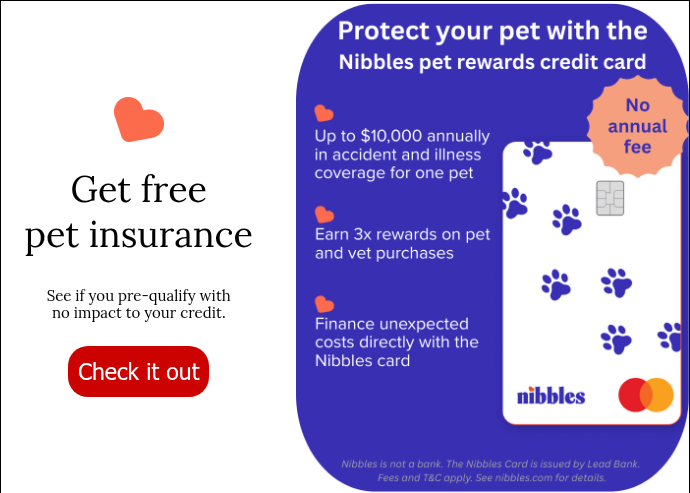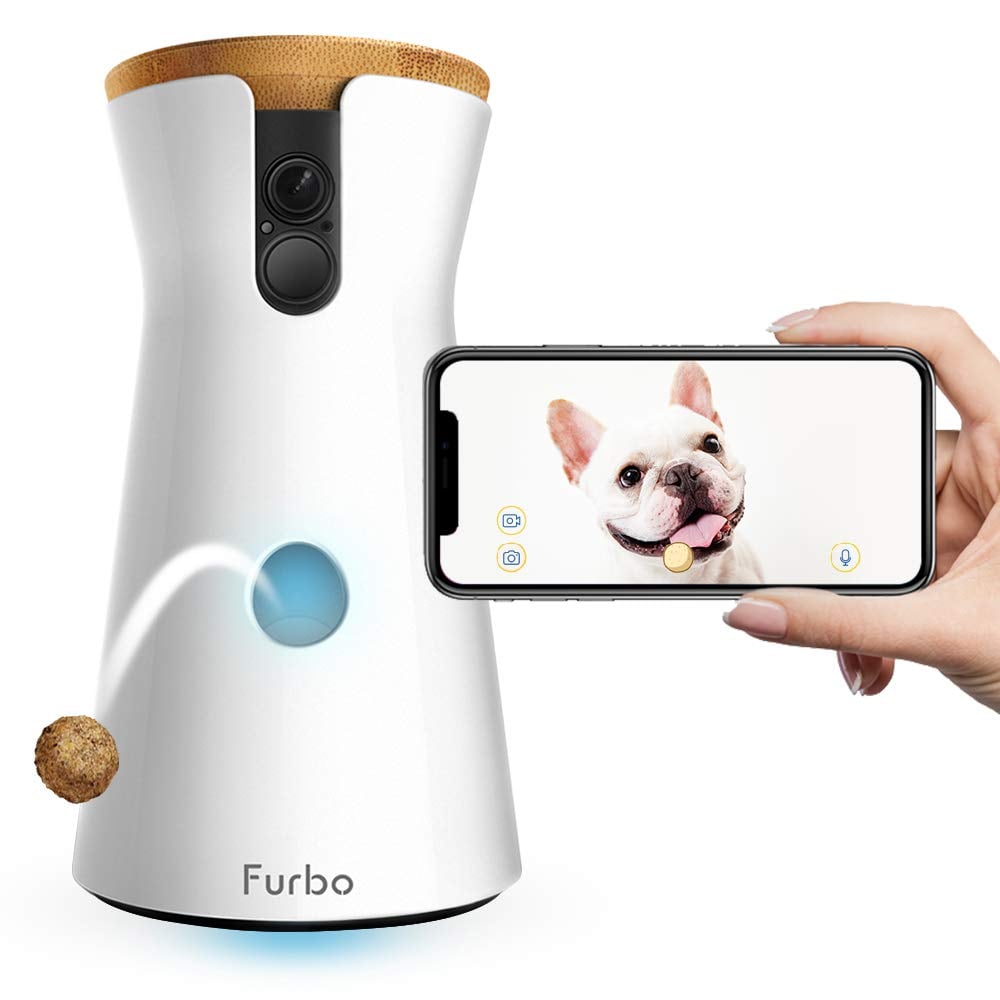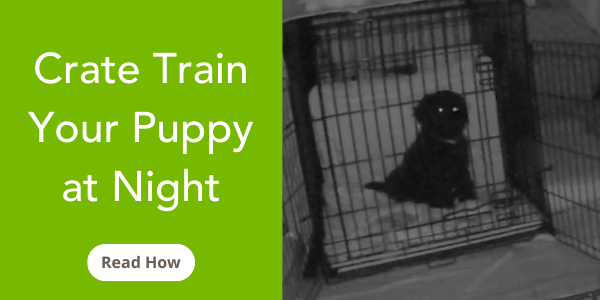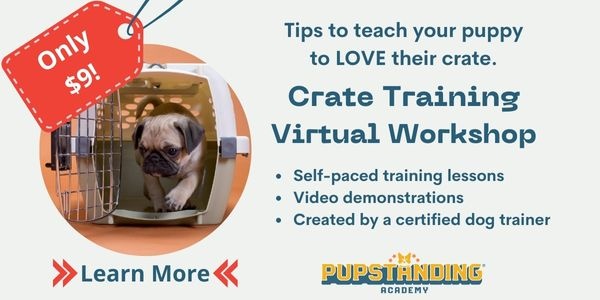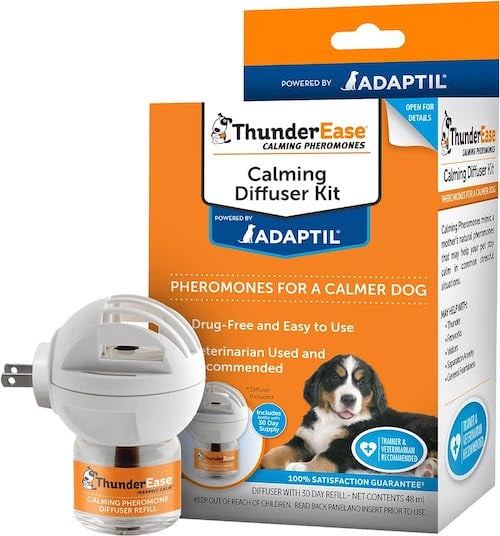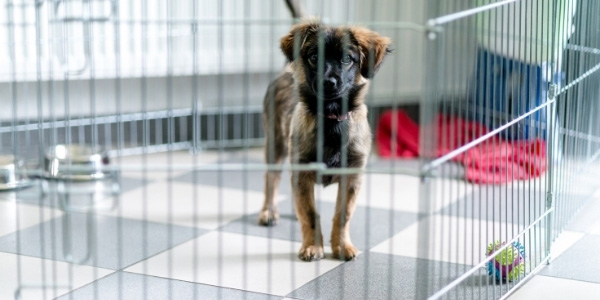
Will Your Puppy Be in Their Crate For a Long Time?
When you start crate training your puppy, it’s important to plan ahead for when you’ll be away longer than your puppy should be crated. This could be anywhere from 30 minutes to 6 hours, depending on age.
Check out this article on how to crate train your puppy for guidelines on how long your puppy should be in their crate.
Puppies need regular potty breaks and can't handle being crated for a long time. This is where setting up a long-term containment area or puppy playpen comes in. Think of this area as the designated "puppy zone."
Having a puppy pen gives you peace of mind when you need to get things done without bringing your puppy along, and means you don't need to feel stressed about crating them for too long.
What Is a Puppy Pen and Long–Term Confinement Area?
Your long-term confinement area for your dog is a place larger than your puppy’s crate that provides:
- Appropriate potty spot*
- Play area
- Access to water
- Rest area (usually your puppy's crate)
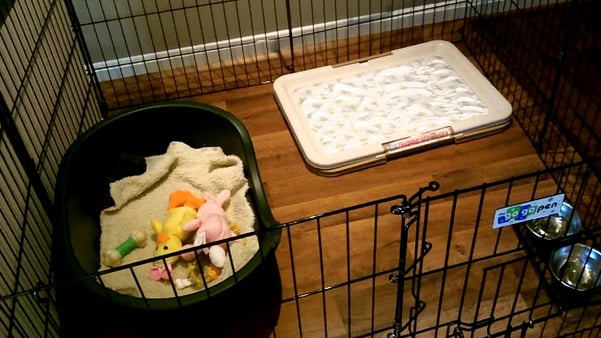
The size of the pen depends on the size of your puppy, but shouldn’t be so big that they have potty accidents anywhere but in the designated potty area.
This kind of confinement helps to potty train your puppy, prevents destructive chewing, keeps them safe from household hazards, and helps them learn that being alone is nothing to worry about. Their puppy zone is managing their environment to help them make good choices about where to potty, what to chew on, and how to entertain themselves when you’re not around.
*A Note About Potty Pads in Your Puppy's Playpen
Here's an example of my puppy's playpen area.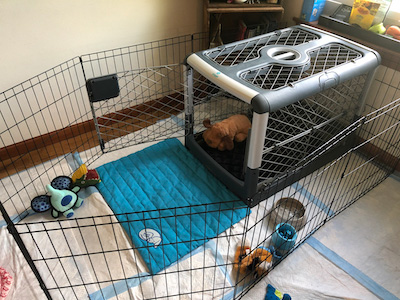 Notice how I put potty pads over the entire floor surface? I only did this because I was not using pee pads in his house training plan at all — so they are only there to protect my floors in case of a potty accident. It was easy to clean up because I could just toss the soiled pad and replace it by taping down a new one.
Notice how I put potty pads over the entire floor surface? I only did this because I was not using pee pads in his house training plan at all — so they are only there to protect my floors in case of a potty accident. It was easy to clean up because I could just toss the soiled pad and replace it by taping down a new one.
My goal was for Fozzie Bear to not go potty on anything indoors, so this did not affect his house training; it was just a convenience for me. In fact, during his potty training, he only had one accident in his playpen because I missed the signs he needed to go outside.
If you do not plan on using potty pads long-term, this might be the right setup choice for you and your puppy. However, if your puppy will be in their pen for long periods without a potty break, loves to chew on or shred potty pads, or you're unable to keep an eye on them while they're in their pen, I would recommend sticking with an appropriate and clearly defined potty spot within their playpen.
Where Should You Put Your Puppy's Pen?
Your puppy's pen should be in an easy-to-clean space and free of any items or furniture you don’t want your puppy to chew on. You’ll want this space fully enclosed, so pick a room where you can block the door with a secure gate so your puppy can’t escape, like a laundry room or bathroom.
If you don’t have a small room that works, it’s easy to set up an exercise pen around your puppy’s usual crate area. If you use an exercise pen, make sure it's either securely attached to your dog's crate (here's a crate and ex-pen system that is designed perfectly for this purpose) or set up securely against a wall and other anchor points so your puppy can't knock it over and escape.
Watch this video to see a great example of using ex-pens attached to a crate to create a puppy zone:
Using a Portable Pop-Up Puppy Playpen
If space allows, having two puppy playpens is ideal. The first is a more permanent location, attached to your puppy's crate. The second can be a portable playpen, allowing you to easily move it around with you during the day (or even use it outdoors while working on socialization before your puppy has been fully vaccinated).
I use and recommend "pop-up" pens, like this Jespet pen. It has a removable mesh cover to prevent bouncy puppies from leaping over and out, and is lightweight but sturdy. I do not recommend leaving a puppy completely unsupervised in a portable playpen, as if they are determined enough, they could chew through the mesh paneling.
Here's a photo of my dog Fozzie as a puppy, sleeping after his midday snack in his pop-up playpen:
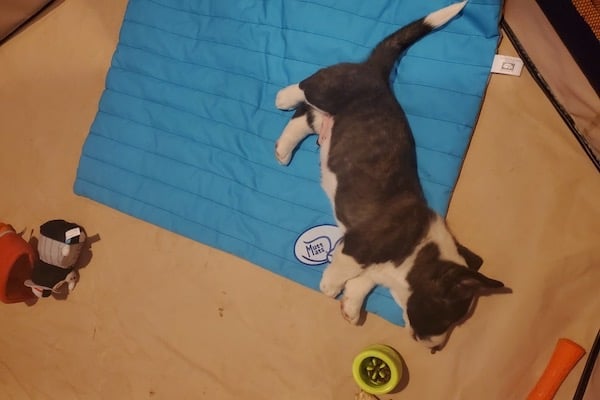
This second portable pen does not need to be as fully "stocked" as the regular playpen, just make sure to have water, a blanket or dog bed where your puppy can comfortably rest, and a few puppy-safe toys or food puzzles. You may consider potty pads in the pop-up playpen, but only do this if you are regularly using pads in your puppy's housetraining.
Video Monitoring for Your Puppy's Pen
Setting up a pet camera makes it easy to always keep an eye on your puppy, whether from another room or while you're away from home. Having a treat-dispensing option is fun too, and makes it easy to reward your puppy for good behavior while you're gone. One of the most popular pet cameras is the Furbo – it has a treat dispenser and two-way audio.
How to Set Up Your Puppy's Playpen
Crate or Sleeping Area: Have your puppy’s regular crate on one side of the zone, with the door left open so your puppy has easy access when they want to rest.
Make sure the crate has appropriate chew-proof bedding. You can tape down your dog’s bed so it stays put and can’t be pulled out and chewed on. If you have a power chewer puppy who is most likely to rip up their bed (and the tape), a bed like this indestructible raised cot is a great chew-proof option.
I highly recommend crate training your puppy, but if you choose to not use a crate, provide a comfortable sleeping area in one corner of their puppy zone.
Pro Tip: Putting your puppy's crate inside the long-term confinement area has multiple benefits. It's not only the place they can go to sleep, but it builds positive associations with the crate. Having easy access into their crate and their comfy bed reinforces that it's a great place to be by choice, and that the door isn't always closed on them.
Designated Potty Area: This area should be as far away from the crate and sleeping area as possible. Tape down puppy pee pads or use an indoor turf potty spot. Creating a potty spot with raised edges — like this dog litter box option — helps prevent toys from being pushed into the potty zone. You'll want to make sure that this area is set up in a place where your flooring is more durable or not as "precious" to you, like a laundry room or tiled kitchen floor.
Appropriate chew toys: Choose toys that are safe to leave with your puppy while they’re unsupervised. This could include interactive treat toys to help them pass their time and stimulate the brain.
Food: Your puppy’s food should be given in a stuffed Kong toy or similar work-to-eat toys. You can tether Kongs to the edge of the puppy zone to prevent them from rolling into the potty area. Simply thread a rope through the Kong and tie a knot on one side, pulling it tight inside the Kong before stuffing and tethering. (If your dog loves to chew and you think they'll chew through the rope tether, try a different style of work-to-eat toy for your pup's safety.) Check out some of our favorite interactive feeders to try with your puppy.
Water: Place your puppy’s spill-proof water bowl or hang up a no-drip water bottle near their sleeping area.
Teaching Your Puppy to Settle in Their Playpen
You’ll want to make sure your puppy has a positive association with their designated zone, and you’ll want to introduce the area similarly to how you introduced your puppy to their crate. You want them to love being in their puppy zone; your puppy will learn that their zone is where all the good stuff happens!
Follow the steps below to slowly introduce your dog to their puppy playpen:
- Take your puppy out for a potty break or walk.
- Put your puppy in their playpen and give them a stuffed Kong or another high-value chew toy.
- Leave your puppy alone with their yummy treat for a few minutes. Don’t make a big deal about leaving them there without you. The more fuss you make about leaving, the more likely your puppy may develop problems with being away from you (and that's no fun for anybody!). This step is done while you stay home or leave for a very short period. See step 5 for more detail.
- Let your puppy out of their zone, preferably before they finish de-stuffing their Kong. Keep your return low-key — you want your dog to learn that humans coming and going is no big deal.
- Repeat steps 1–4, gradually increasing the length of time your puppy is alone in their area. Practice this a few times throughout the day, every day. You can start leaving the house for a few minutes at a time as your puppy practices being alone. Go check the mail or take the trash out. Start small and gradually build up to running short errands or, if you have children, picking them up from school while your puppy hangs out in their zone.
If your puppy struggles with being in their playpen or crate, sign up for our Puppy Essentials Crate Training Workshop. You'll receive instant access to self-paced and in-depth training modules, demonstrative videos and photos, and more — all for only $9!
Pro Tips for Puppy Confinement Areas
- Does your puppy bark or whine when you leave them in their pen? Be careful not to give them any attention, go back to them, or let them out when they do this. You don’t want your puppy to learn that barking gets them your attention or being let out of the zone. Instead, wait until they’ve been quiet for 10–15 seconds before you give them any attention or let them out.
- Plug in a calming pheromone diffuser in the same room as the puppy zone (but not somewhere where your pup can reach or chew on it) to encourage relaxation and calm behavior.
- Make sure that their zone has enticing chew and work-to-eat toys available so your puppy has something fun to do while alone. This can help prevent boredom barking and provides great mental enrichment.
- Give your puppy some exercise before putting them in their designated area. A tired puppy is a good puppy, and if they’re tired from a walk or a game of tug, they’ll be less likely to boredom bark and more likely to settle down for a nice, long nap. Tug is a great way to introduce the Drop It cue to your puppy — watch Finnegan the Portuguese Water Dog puppy demonstrate in this video:
- As your puppy matures, you can start to make the area larger to help transition to leaving them alone in the home unsupervised when they are an adult.
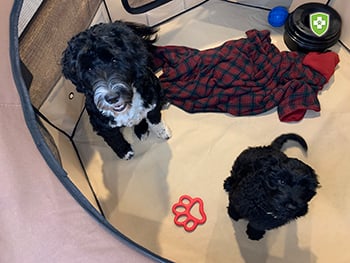
When to Leave Your Puppy in Their Pen
Use the puppy pen whenever you need to leave your pup unsupervised longer than they can be crated. You’ll have more peace of mind knowing that your puppy is safe, comfortable, and not chewing your couch to pieces while you’re away.
Putting your puppy in their playpen is a great idea if you work from home, as it gives them a safe area to relax or play while you get some work done. This is especially important for preventing separation anxiety if you work primarily from home. Your puppy also needs to learn how to entertain themselves without constant interaction from you, so using their playpen even while you're home is a perfect opportunity.
Sometimes puppies just need a break, especially if there's a lot of activity going on in your home. If they are getting too nippy or barking at playing children, give them a chance to settle a bit in their pen. We all need a break sometimes, and our puppies are no different. Eventually, their pen can become a more "adult-dog" safe space.
You can also have them in their pen while you have guests coming and going from your home, or while you eat meals. This will prevent any door dashing, counter surfing, or other unwanted behaviors from developing. Once the door is closed or everyone is done eating, bring your puppy out to say hi to everyone and work on socialization.
We'd love to hear how your Puppy Zone is working out in your home! Let us know in the comments what's worked best for your home set-up.


